hilles
食紅について少し疑問に思ったことがあったのでこの記事を書いています。というのもタンドールを使った料理を作るパンジャビ地方のレシピを http://food.ndtv.com/lists/10-best-punjabi-recipes-724174 見ていたところあまりに赤い色をしたタンドリーチキンが目に入ったからです。シェフの Aditya Balがレシピを提供しています。本当に赤いタンドリーチキンです。この赤さはチリだけではなく、食紅の赤にもみえます。レシピを調べることにしました。

Ingredients
8 large Chicken pieces with skin (2 pieces breast, 2 pieces of thighs, a couple of wings)
Oil, to baste
For the marinade:
4 tsp red chilli paste
3 Tbsp ginger and garlic paste
2 tsp chaat masala※
1 Tbsp oil
3 Tbsp curd
Salt, to taste
Juice of 1/2 lemon
For the tandoori masala※※:
2 sticks cinnamon
1 Tbsp black peppercorns
5 green cardamom
3 brown cardamom
2 tsp coriander seeds
2 tsp cumin seeds
3 cloves
1 bay leaf
3/4 tsp turmeric
※chaat masala をほかのレシピから引用してみました。Ingredients;http://www.tarladalal.com/Chaat-Masala-(-Chaat)-2788r
から。
1/4 cup cumin seeds (jeera)
1 tbsp black peppercorns (kalimirch)
1/4 cup dried mango powder (amchur)
2 tbsp black salt (sanchal)
1 1/2 tbsp salt
1/2 tsp asafoetida (hing)
※※tandoori masala をほかのレシピから引用してみました。Ingredients;http://www.food.com/recipe/tandoori-masala-spice-mix-333539 から。
1 teaspoon garlic powder (Lasun)
1 teaspoon ground ginger (Adrak)
1 teaspoon ground cloves (Lavang)
1⁄2 teaspoon grated nutmeg (Jaiphal)
1 teaspoon mace (Javitri)
1 1⁄2 tablespoons ground cumin (Jeera)
2 tablespoons ground coriander (Dhania)
1 teaspoon ground fenugreek (Methi)
1 teaspoon ground cinnamon (Tuj or Dalchini)
1 teaspoon fresh ground black pepper (Kalimirchi)
1 teaspoon ground brown cardamom (Elaichi)
1 teaspoon red food coloring
ふつうはこのようにタンドリーマサラの中に食紅が入っているのです。しかし、最初のレシピのどこにも食紅の文字はありません。赤い要素といえば red chilli paste だけです。

上の絵は http://www.margaretshome.com/category/techniques/ から引用しました。チリペイストの材料です。左上の赤黒いチリ:カシミリチリが本来の材料ですが、代用品としてそのほかのチリが選択されています。カシミリチリは辛さはないのですが Deggi MIrch は、栽培場所、天候などによって時に辛味があるようです。
チリペイストだけでこんなに赤くなるものでしょうか。チリペイストについてもう少し調べてみることにしました。
チリペイストの作り方 ( Making your own Chinese hot chili paste:La jiao jiang)
http://www.teenytinykitchen.com/chinese/making-chinese-chili-paste-la-jiao-jiang/#sthash.oR3FKeKg.dpbs から引用しました。
La Jiao Jiang ( hot chili paste )
3-5 hot peppers (Go with a pepper that fits the degree of heat you’re looking for;
I used Anaheim for this batch and wished I’d gone with something hotter.)
1/4 clove garlic, minced very finely (optional, or a shallot as a substitute is also nice)
1 healthy tablespoon of vegetable oil
1 dash salt
1 splash to 1 teaspoon rice or white vinegar
ペッパーをフードプロセッサーで刻み、ガーリック又はシャロットを入れる。乾燥したペッパーも同様に使える。オイルを熱して塩を入れる。ペッパーを加えて汁を出す。火を弱めてガーリックを加える。ヴィネガーを入れて蓋をして冷ます。ペッパーが濃い赤になるまで時々かけ混ぜながら10-20分間煮る。
疑わしいと思われるレシピの中のアナハイムを調べました。
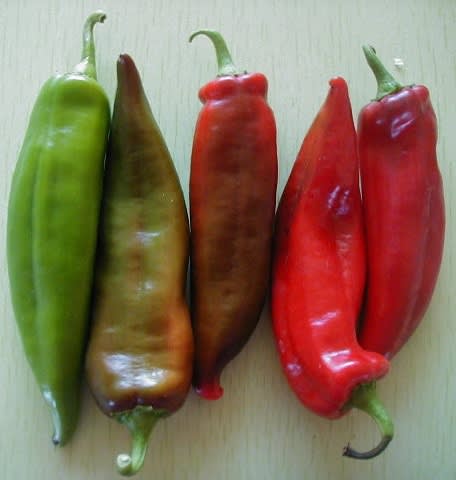
これがアナハイムです。産地によって若干の形の違いはありますが、このように少し丸みを帯びたものから、もう少し長細いものまであります。辛みはほとんどなく、熟れるともう少し赤くなります。
http://www.margaretshome.com/what-is-kashmiri-chilli-powder/から引用しました。
Byadagi, Kashimini Chilli powder, South indian Red, Deggi Mirch, Gundu 絵の中のチリは全て甘唐辛子です。特にByadagiは深紅色をしており鮮やかな色なので口紅にも使われているそうです。

Bydagi chilli の絵は http://www.thehindu.com/news/national/karnataka/highyielding-hybrid-byadgi-chilli-launched/article4814919.ece から引用しました。

Kashimini Chillliの絵はhttps://soulnspiritblog.com/tag/spicy-food/ から引用しました。

Gundu chilli の絵は http://www.shutterstock.com/pic-88777951/stock-photo-round-red-chili-pepper-plant.html から引用しました。
チリが栽培されだしたのはBC 6,000年頃のメキシコであり、1400年後半頃にポルトガルに渡り、インドに渡ったのは今からおよそ400年前とされています。1650年には熱帯地方で広く栽培されるようなったようです。日本への伝来は、1542年にポルトガル人宣教師が大友義鎮に献上したとの記録があり、文献には1552年 にポルトガル人宣教師バルタザール・ガゴが大友義鎮(出家後に宗麟と称す)に種を献上したと記されています。
トウガラシ属の中にはトウガラシ種 ( C. annuum )、ロトコ種 ( C. pubescens )、アヒ・アマリージョ種 ( C. baccatum )、ウルピカ種、シネンセ種 ( C. chinense )、キダチトウガラシ種 ( C. frutescens )、チャコエンセ種 ( C. chacoense )があります。パプリカ、ピーマンはトウガラシ種に入ります。
ギネスブックで世界一辛い唐辛子と認定された「ブート・ジョロキア」はアッサム地方、Aleppo はシリア、トルコ、Alma Paprika はハンガリー、BIrds Eye は東南アジア、Cayenne はギアナ、Jwala はインド、Pepperoncini はイタリア原産です。現在地球上で栽培されているチリの中には南米原産ではないトウガラシも多数あります。
変種が生まれることが多く、しかも土地土地で交雑が繰り返されており元の種を特定することは難しいです。大雑把な分類は下記のサイトで見ることができますので参考にしてください。
http://www.pepperscale.com/hot-pepper-list/
https://hort.purdue.edu/newcrop/proceedings1996/V3-479.html
最初のレシピは食紅を使わずにチリだけで赤い色を付けていたようです。本当に勉強になりました。
ここから先は私のメモ書きになります。
Chilli Pepper、唐辛子・・・・・考えてみれば不思議な言葉です。これらの名前の由来は?
Oxford Dictionariesから;
“Chilli” はメキシコ中部に住むインディアンの部族、ユト・アステカ語族 ( Uto-Aztecan ) に属するナワトル族がトウガラシを指して言う言葉です。
スペインの支配下に入って1600年初頭にスペイン語の中に繰り込まれたようです。
この頃の植物学者にレオンハルト・フックス(Leonhart Fuchs, 1/17/1051-5/10/1566, ドイツの医師、植物学者、『植物誌』で知られている。)がいます。1542年著の本草書『植物誌』(De Historia Stirpium Commentarii Insignes , 『新植物誌』、『薬草誌』とも)で、植物について、ディオスコリデス、プリニウス、ガレノスなどギリシャ・ローマの古典に基づいて薬効を説明し、植物の形態に注目して、薬草以外の植物も取り上げ、植物学の確立に貢献しました。( Wikipedia ) から。この中からチリの画像を選び出して、チリをなんという名で呼んでいるのか調べてみよう。
http://waimann.de/capitel/281.html から引用しました。
Leonhart Fuchs: Das Kräuterbuch von 1543
Von Indianischem Pfeffer. Cap. CCLXXXI.
Calechutischer Pfeffer ( CCCCXVIII ) ( Calechutischer/ calecutischer/Calicut Pepper )
Abbildung: Seite 726

Calechutischer Pfeffer = Capsicum annuum

Langer Indianischer Pfeffer ( CCCCXIX ) ( Long Indian Pepper )
Abbildung: Seite 727

Breyter Indianischer Pfeffer ( CCCCXX ) ( Capsicum annuum )
Abbildung: Seite 728
上の絵の根のあたりに、上から順にカルカッタのペッパー、インドのロングペッパー、インドのペッパーと書かれています。従来通りの説の通り、アメリカ大陸をインドと間違えて、そこで見つかったペッパーなのでインドの地名が付いている? 1542年に著した書物に? 時代を少し下って、
John Gerard Gerard Herball 1596 から

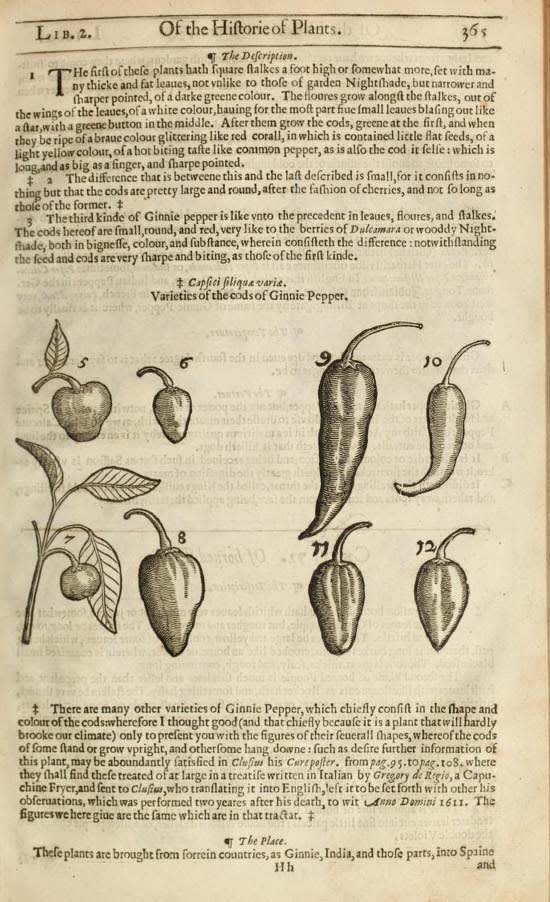

もう少し時代を下って、
|
|
CULPEPER'S COMPLETE HERBAL 1652 から |
|
|
GUINEA PEPPER Names. Called also cayanne pepper and bird pepper. Description. There are several kinds. In general it grows with an upright, firm, round stalk, with a certain pith within it, about two or three feet high spreading into many branches on all sides, from the very bottom, which divide themselves again into other smaller branches at each joint whereof come two long leaves upon short footstalks, somewhat bigger than those of nightshade, with several veins, not dented about the edges, and of a dark green colour: the flowers stand severally at the joints, with leaves like the flowers of nightshade, consisting most usually of five, and sometimes six, white small-pointed leaves, standing open like a star, with a few yellow threads in the middle, after which come the fruit, either great or small, long or short, round or square, as the kind is, either standing upright or hanging dwn, as their flowers shew themselves either of this or that form: the seeds are very numerous, kidney-shaped, and a little compressed: the root annual and fibrous, spreading plentifully in the ground, but perishing, even in hot countries, after it has ripened all its fruits. Place. It is a native of the Indies, but will bear the air of our climate, and ripens its fruit with us if brought forward in a hot bed in the spring, and afterwards planted out in the open ground. Time. They do not sow it in hot countries before the end of March or beginning of April, and at the soonest they do not flower before August following, and their red pods ripen not thoroughly until November, when they will continue both with flowers and fruit most of the winter, where the weather is not very intense; but in very cold climates they perish with the first frost, and therefore must be carefully housed in order to be preserved. Government and virtues. All kinds of guinea pepper are under Mars, and are of a fiery, sharp, biting taste, and of a temperature hot and dry, to the end of the fourth degree; they burn and inflame the mouth and throat so extremely that it is hard ot be endured, and if it be outwardly applied to the skin in any part of the body, it will exulcerate and raise it as if it had been burnt with fire, or scalded with hot water. The vapours that arise from the husks or pods, while a person opens them to take out the seed, (especially if he beats them into powder, or bruises them) will so pierce the brain by flying up into the head through the nostrils, as to produce violent sneezings, and draw down abundance of thin rheum, forcing tears from the eyes, and will pass into the thoat, adn provoke a sharp coughing, and cause violent vomiting; and if any shall with their hands touch their face or eyes, it will cause so great an inflammation that it will not be remedied in a long time by all the bathing thereof with wine or cold water that can be used, but yet will pass away without further harm. If any of it be caste into fire, it raises grievous strong and noisome vapours, occasions sneezing, coughing, and stron vomiting to all that be near it; if it should be taken simply of itself (though in very small quantity, either in powders or decoction) it would be hard to be endured, and might prove dangerous to life. Such are the dangers attending the immoderate use of these violent plants and fruits; yet, when corrected of their evil qualities, they are of considerable service. Take the ripe pods of any sort of the guinea-pepper, (for they are in property all alike) and dry them well, first of themselves, then in an oven, after the bread is taken out: put it into a pot or pipkin, with some flower, that they may be quick dried; then cleanse them from the flour and their stalks, if they have any; cut both husks and seeds within them very small, and to every ounce of them put a pound of wheat flour: make them up together into cakes or small loaves, with leaven proportioned to the quantity you make; bake these as you do bread of the small size, and when baked, cut it again into smaller parts and thin; bake it again that it may be as dry and hard as a biscuit, which beaten into fine powder and sifted, may be kept for any of the uses hereafter mentioned, or may serve instead of ordinary pepper to season meat or broth for sauce, for it not only gives it a good taste or relish, but tends to discuss the wind and cholic in the body. It is of singular service to be used with flatulent or windy diet, and such as breeds moisture and cridities; one scruple of the said powder, taken in a little broth of veal or of a chicken, gives great relief and comfort to a cold stomach, causing phlegm and such viscous humours as lie low in the bottom thereof, to be voiced: it helps digestion, for it occasions an appetite to meat, provokes urine, and taken with saxifrage water expels the stone in the kidnies, and the phlegm that breeds it, and takes away dimness or mistiness in the sight, being used in meats. Taken with pillulæ aleophanginæ, it helps the dropsy: the powder, taken for three days together in the decoction of penny-royal, expels the dead birth, but if a piece of the pod or husk, either green or dry, be put into the womb after delivery, it will make them barren for ever after; but the powder, taken for three or four days fasting, with a little fennel seed, will ease all the pains fo the mother. The same also made up with a little powder of gentian and oil of bays, into a pessary, with some cotton wool, brings down the courses: and the same mixes very well with an electuary, for the cough, helps an old inveterate cough; being mixed with honey, and applied to the throat, it helps the quinsey; and made up with a little pitch or turpentine, and laid upon any hard knots or kernels in any part of the body, it will dissolve them, and not suffer any more to grow there; and being mixed with nitre, and applied, it takes away the morphew and all freckles, spots, marks, and discolourings of the skin; applied with hen's grease, it dissovles all cold imposthumes and carbuncles, and mixed with sharp vinegar dissolves the hardness of the skin; mixed with unguentum de alobastro, and the reins of the back anointed therewith, it will take away the shaking fits of agues; a plaister made therof with the leaves of tobacco, will heal the sting or biting of any venomous beast or animal. The decoction of the husks themselves, made with water, and the mouth gargled therewith, helps the tooth-ach, and preserves the teeth from rottenness; the ashes fo them being rubbed on the teeth, will cleanse them, and make them look white. The decoction of them in wine helps the hernia ventosa, or watery rupture, if applied warm morning and evening. If put to steel for three days together in aqua vita, it helps the palsy, the place affected being bathed therewith: and steeped for a day in wine, and two spoonfuls drank thereof every day, fasting, it is of singular service in rendering stinking breath sweet. It is sometimes given as one of the highest stimulants in cold sluggish phlegmatic disorders, in paralytic complaints, in relaxations of the stomach, and for promoting the efficacy of aloetic and nervous medicines, and in hysteric and other female diseases. A little of the pulpy part of the fruit, held in the mouth, cures the tooth-ach; and if bruised and applied externally to the part affected, in form of a poultice, with the addition of crumbled bread and honey, enough to bring it to a proer consistence, it is good for the quinsey.
Guinea pepper =: Piper indicumAlternate Title(s): Piper indicum Author(s): Blackwell, Elizabeth, active 1737., engraver Subject(s): Capsicum Extent: 1 print : 37 x 25 cm. Technique: etching and engraving, hand-colored Permanent Link: http://resource.nlm.nih.gov/101456760 |
バシリウス・ベスラーまたはバジル・ベスラー(Basilius Besler または Basil Besler、2/13/1561-3/13/1629)はドイツの薬剤師、植物学者、植物画家。ドイツ、アイヒシュテットの司教で植物愛好家の、ヨハン・コンラート (Jhann Konrad von Gemmingen)が造った庭園で栽培された植物を詳細に描いた『アイヒシュテット庭園植物誌』(Hortus Eystettensis)の植物画を描き出版した。


Basilius Besler 1613
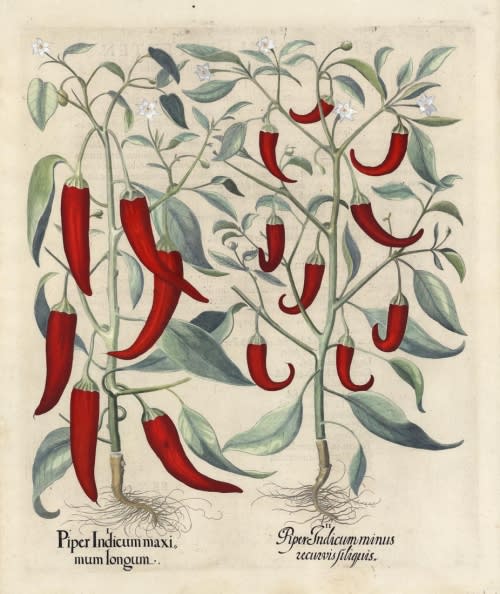
Piper Indicum Maximum longum 1640
Piper indicum で検索するとたくさんの植物画が出てくる。
https://en.wikipedia.org/wiki/List_of_Capsicum_cultivars から;
Major species and their taxonomic varieties:[4]
- Capsicum annuum, which includes bell peppers, sweet/Italian peppers, serrano, cayenne, paprika and jalapeños
- Capsicum baccatum, which includes the South American varieties, such as ají amarillo, ají limon and criolla sella
- Capsicum chinense, which includes all of the Habaneros, Scotch Bonnets, Trinidad Scorpions, the Bhut Jolokia and the Carolina Reaper.
- Capsicum pubescens, which includes the Rocoto and Manzano pepper, and are distinctive plants in having violet flowers, black seeds and hairy dark green leaves and grows as a large multi-stemmed vine up to 5 meters long.[5]
- Capsicum frutescens, which includes the Brazilian Malagueta, the Tabascos and many of the peppers grown in India[6]
- Sometimes C. frutescens is not distinguished as a species separate from C. annuum,[7] while other botanists consider it and C. annuum to be conspecific.[
















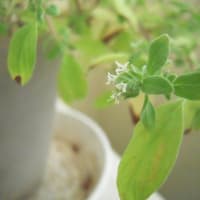
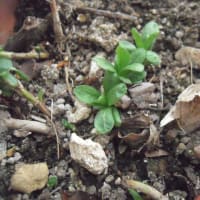

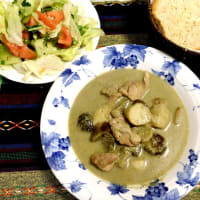
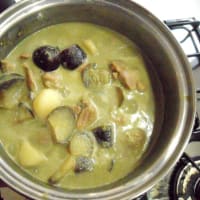
※コメント投稿者のブログIDはブログ作成者のみに通知されます